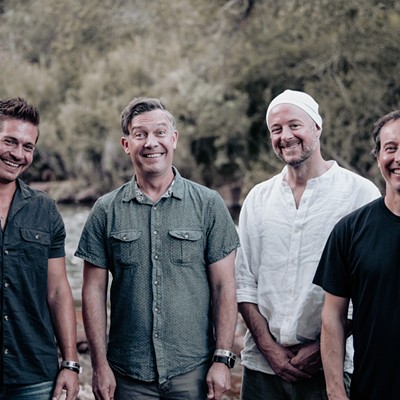It amazes me that there is such a yearning to produce theater in this town. It seems there is always an entity popping up. And although the group members may produce on an irregular schedule or the quality of their work varies greatly, nevertheless, produce they do. (It is legitimate to ask if a community like Tucson can provide enough funding and ticket sales to support all these groups. But that's a conversation for a different time.)
Opening last weekend were the presentations by two new groups that have begun the work of producing shows that will attract and keep an audience. Speak the Speech Theatre Company opened its second-ever show, an interesting piece that has been around for 50 years. The Tucson Alliance of Dramatic Artists, or TADA!, unveiled a world premiere, the winner of a national playwriting contest conducted by the group last year. The play is now receiving its prize—a full production, which is pretty much every playwright's dream (or nightmare, depending).
Speak the Speech chose last fall to introduce itself to Tucson with a challenging piece, a Sam Shepard play called True West. It did pretty well. Its second production, A Company of Wayward Saints, by George Herman and directed by Dan Reichel, is also a challenging piece, but in different ways.
Initially, we are introduced to a group of folks wearing a variety of three-quarter masks and dressed in archaic styles, and it quickly becomes clear that this is a touring theater troupe in the commedia dell'arte tradition. It's a centuries-old style that utilizes stock characters—the most familiar ones to us are probably Harlequin (played here by Charles D. Prokopp) and Pantalone (Stan Stein)—in a catalog of predetermined stories. These stories are then tweaked with improvisation to allow them to be timely and specific to the particular locale in which the players have landed. Also incorporated is the traditional slapstick—a device that can lend rather primitive sound effects and underscore various whacks to the body. There is some juggling and other physical bits, which are quite constrained due to the size of the tiny Cabaret Theatre's stage (and perhaps the players' abilities).
The group is stranded a long way from home and spokesman Harlequin beseeches a member of the audience to agree to provide their means back to Italy if they concoct a winning performance. Scapino (David Wang) and Columbine (Sydney Flynn), along with the rest of the crew—Eric Everts, Renata Rauschen, David Zinke, Don Cline and Lindy Bowser—set about their task.
They proceed with some mildly entertaining shenanigans depicting the history of the human race, but it seems that there is disunity within the group, and as the first act closes, Harlequin announces that they just can't go on. But of course they do, although in a very different vein, as individuals, not their stock characters, and without masks, again portraying the history of man in an economical distillation—birth, adolescence, marriage and death.
The amateur—in the truest sense of the word—players get the story told and deliver enough of Herman's philosophical perspective to provide us with quite a bit to think about. The production is uneven, but each of the players has at least an impressive moment or two. In general, the actors and director do a good job of giving us the text—no mean feat—but are not able to provide clearly its nuance and depth.
One of the most impressive aspects of the performance was those masks. No credit was assigned in the program, but company manager Paul Brunelle responded to an email inquiry, saying that they were designed in New York by Stanley Allan Sherman of Mask Arts Company. He "designed the raw masks and each cast member finished their own masks." It's a good sign for the company that this important element of the production was given a professional priority.
he Tucson Alliance of Dramatic Artists' inaugural production is its first new-play contest winner, Emmett, Down in My Heart, by Clare Coss. It's the true story of how a black teenager from Chicago, Emmett Till, went to visit family in Mississippi and was brutally ravaged and mutilated and then thrown into a river with chain and barbed wire wrapped around his neck, ostensibly for whistling at a white woman. His mother's decision to hold an open-casket funeral in 1955 was one of those critical events that helped coalesce the civil rights movement.
This is powerful and important stuff, and I think Coss has written a very good play. But I don't think this production, under the direction of Sheldon Metz, gives it the theatrical context it needs (and deserves) to ignite the searing impact it could have.
Coss' play covers a lot of ground with a substantial number of characters. There is a clear through-line, but sometimes scenes are acted out; sometimes characters address the audience; sometimes characters are more commentators than characters. The production features Kendrick Stallings as Emmett, Carly Elizabeth Preston as his mother, Mamie, and Seth Fowler as Roy Bryant, who is responsible for Emmett's murder.
Although I understood that this was to be a full production, it really isn't. One of the most important design elements of theater is lighting, and if ever a script could benefit from a sensitive and well-executed lighting plan, this one could. Its subject and style beg for it. Although audience members seemed impressed by the story as it was presented, had it been envisioned with one of the most elemental staples of theater production, this play would have left the audience speechless.
If the acting were more consistent and a directorial "less is more" concept applied to certain scenes, which would have made them less gratuitous and didactic, Coss' play would settle down deep, deep, deeper in our hearts after having torn them asunder.








